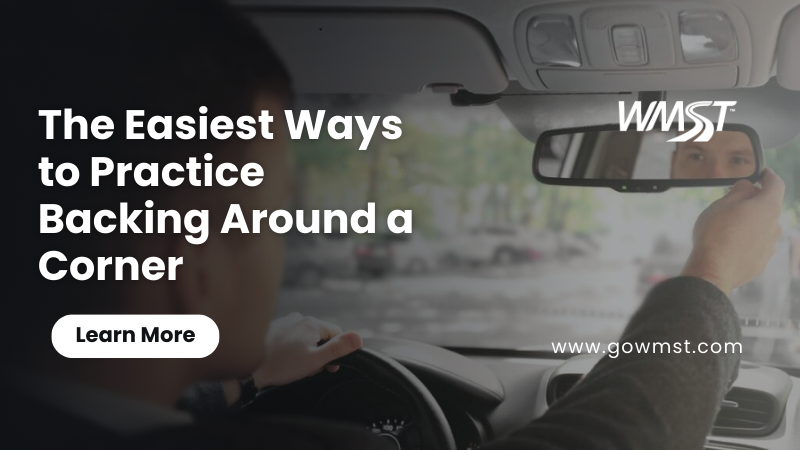Why This Maneuver Is Tested in WA?
In Washington State, the backing around a corner exercise is one of the five Skills Test maneuvers every driver must demonstrate. While it may seem like a simple reverse, it evaluates far more than just your ability to back up.
This maneuver is designed to test:
- Control of the vehicle at low speeds.
- Spatial awareness when turning into tight spaces.
- Observation habits, including mirror use and head checks.
- Decision-making in situations that mimic real-life driving (like backing out ofa driveway or alley).
The Department of Licensing includes this skill because it shows whether a new driver can safely maneuver in restricted areas without causing hazards. At WMST, instructors emphasize that backing around a corner isn’t just about passing the Skills Test, it’s about building confidence for everyday driving situations.
The Step-by-Step Method from WMST Instructors
To help students succeed, WMST teaches a structured method for backing around a corner in WA. Here’s the step-by-step process:
1. Position the Vehicle Correctly
- Stop parallel to the curb a short distance from the corner you will be backing around.
- Approach the corner slowly, come to a complete stop prior to the sidewalk or entering the adjacent roadway to check for pedestrians and traffic..
- Once your back tire is at the corner, strive to stay about 18 inches from the curb (close enough to maintain control but not so close that you risk hitting it).
2. Signal and Check Surroundings
- Signal right and check your blind spot when pulling to the curb
- Complete a 360° visual check: mirrors, blind spots, and behind the vehicle.
3. Begin Reversing Slowly
- Shift into reverse and release the brake gradually.
- Keep your speed walking pace or slower.
4. Use Proper Observation
- Look over your right shoulder through the rear window.
- Glance at mirrors only for quick reference, not as your primary guide.
5. Steer Smoothly Around the Corner
- As the rear wheels approach the corner, begin turning the wheel.
- Make small, controlled steering adjustments rather than sharp turns.
6. Straighten Out After the Turn
- Once the vehicle clears the corner, straighten the wheel.
- Continue backing in a straight line until the examiner instructs you to stop.
WMST instructors stress that smooth, steady control is more important than speed. Taking your time shows mastery and confidence.
Common Mistakes to Avoid While Reversing
Many students lose unnecessary points—or fail the maneuver—because of avoidable mistakes. Here are the errors WMST frequently observes:
- Crossing the center line into the opposite lane.
- Failing to check blind spots and signalling when pulling to the curb and when re-entering traffic.
- Turning the wheel too late, which causes the car to swing wide.
- Relying only on mirrors or back-up camera instead of physically looking back.
- Touching or climbing the curb, which results in point deductions.
- Backing too quickly, leaving no time for corrections.
- Failing to stop prior to the sidewalk or entering the adjacent road to check for pedestrians.
Instructors recommend practicing at low speeds until the steering movements feel natural. Remember: examiners value safety and awareness over perfection.
How to Judge Distance and Clearance?
One of the hardest parts of backing around a corner is judging where your car is in relation to the curb. WMST provides these tips to improve accuracy:
- Use reference points. For many vehicles, when the rear wheel passes the corner, that’s your cue to begin turning.
- Check mirror alignment. Your right-side mirror should show the curb at a consistent angle without drifting closer or farther.
- Glance out your passenger side mirror. This helps confirm how close your car is to the curb.
- Practice with cones or chalk lines. These create safe boundaries that simulate curbs without risk of damage.
Over time, students develop a natural feel for vehicle spacing. WMST calls this “building your driver’s eye”—the ability to judge space without second-guessing.
Building Muscle Memory Through Practice
Like any skill, backing around a corner becomes easier with repetition and muscle memory. WMST encourages students to:
- Practice in low-pressure environments. Start in an empty parking lot before moving to residential streets.
- Repeat short sessions. Ten minutes of focused practice a few times a week is more effective than one long session.
- Mix up scenarios. Try different corners, curbs, and vehicle sizes if possible.
- Get instructor feedback. Professional guidance helps correct small errors before they become habits.
By practicing consistently, students often find that backing around a corner—once intimidating—becomes second nature.
FAQs
Do I have to signal while backing around a corner?
Yes. You must signal when pulling to the side of the road and when re-entering traffic.
What if I cross the center line?
Crossing into the opposite lane may result in point deductions. In some cases, it can cause an automatic fail if it creates a safety risk.
Can I use mirrors only, or must I look back?
Examiners require drivers to look over their right shoulder as the primary method. Mirrors are supplemental only.
How many points is this maneuver worth?
Each maneuver on the Skills Test is scored, and backing around a corner is a critical component. Mistakes here can lower your score significantly.
Conclusion
Backing around a corner in WA can feel like one of the toughest Skills Test maneuvers—but with the right method and plenty of practice, it’s entirely manageable. WMST’s instructors break the process into clear steps, helping students master observation, steering, and spacing.
By learning to avoid common mistakes, judging distance accurately, and practicing until movements become second nature, you’ll not only pass the Skills Test but also gain a skill that’s genuinely useful in everyday driving.
At WMST, the focus isn’t just on passing—it’s about building confident, capable drivers prepared for Washington’s roads.

